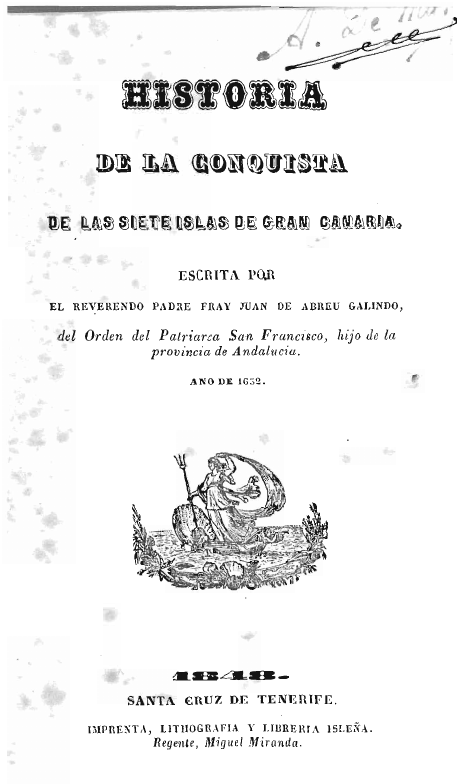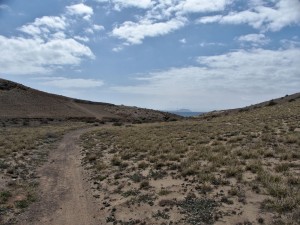The Indigenous Pacts of Gran Canaria and Tenerife: A Chronological and Contextual Review
<img class="aligncenter" src="http://proyectotarha.org/wp-content/uploads/2016/04/los-pactos-i…
<img class="aligncenter" src="http://proyectotarha.org/wp-content/uploads/2016/04/los-pactos-i…

Front cover of the 1848 edition of the History of the Conquest of the Seven Islands of Gran Canaria, by Brother Juan de Abreu Galindo (source: Memoria Digital de Canarias).
It is true that many have claimed telling something about these islands; but they chose whatever suited their matter, and some of them, not having full news about, went brief and although what they said was very little, […] it has been a great argument to mean that not so low karats was the renown of the Isles of Canaria […].
Brother Juan de Abreu Galindo (Prologue to the History of the Conquest of the Seven Islands of Gran Canaria) –1848 Edition–
Leaving little room for doubt, this is perhaps the best known and influential work of the Canarian historiography.
(Post extended and amended on 10 December 2023)
Still hot in the media and social networks the controversial measure adopted by the Cabildo de Gran Canaria consisting of exterminating the guanil goats living in a number of protected natural areas on the Island, we deal here with the origin of such an autochthonous term.
,%20Le%20Canarien,%20tomo%20I_portada_14230f442d9ad53d95eb03b5aa705aab.jpg)
Front cover of the first volume of Le Canarien 1959 edition by Professors Elías Serra Ràfols and Alejandro Cioranescu (source: Biblioteca Virtual Viera y Clavijo).
Le Canarien (The Canarian) is the oldest of the known Canarian chronicles. Originally written over six-hundred years ago, it is the first specific account almost entirely devoted to the European conquest of the Archipelago. Its initial authors, two French priests: Jehan Le Verrier and Pierre Boutier, chaplains to the conquest expedition assembled in 1402 by Norman Baron Jehan IV de Béthencourt and his partner, Pictavin Knight Gadifer de La Salle, as both of them admit:
[…] Gadifer de La Sale and Jehan de Béthencourt, knights born in the Kingdom of France, have undertaken this voyage to honor God and for maintenance and increasement of our holy faith, to parts of the South, to certain islands that are on the side thereof, which they call islands of Canaria inhabited by infidels people with different laws and different languages, […] with the intention of turning them and attract them to our faith; That is why this book is called the Canarian. And we, Brother Pierre Boutier, monk of Saint-Juoin-des-Marnes and Mr. Jehan Le Verrier, priests and chaplains and servants of the knights named above, have begun to write down all the things that happened to them from the beginning and the whole form of their government, of which we could have had true knowledge, since they left the Kingdom of France until […] Béthencourt arrived here at the islands; and thereafter came the writing in other hands, that will resume it with all the truth until the end of their conquest.
Le Canarien (text G) –SERRA (1964), pp. 14-16– (this translation by PROYECTO TARHA).
Truth is that those other hands were not as accurate as the original authors expected. In fact, having either the original or originals dissappeared, the two oldest known copies of this account are perfect examples of hagiographic manipulation.

The ravine and path leading to the archaeological site of San Marcial del Rubicón, Lanzarote (source: PROYECTO TARHA).
Et demourerent euls et ceuls de l’isle Lancelot en bon accord. Apres commencerent un chastel qui s’apelle Rubicom, et laisserent la une partie de leurs gens;
And were well agreed them and those of the island of Lanzarote. Then they began a castle named Rubicon, and left there part of their people;
Le Canarien (text G) –SERRA (1964), pp. 24-25– (this translation by PROYECTO TARHA).
Its characters never knew. Probably most of the hundreds of tourists who weekly lie in the sun just a few steps away will not either. But over six hundred years ago, on the sandy mouth of this humble ravine, an experiment of great historical significance was carried out.